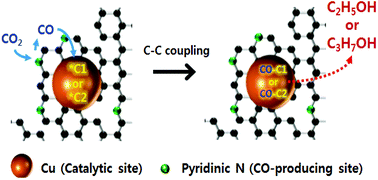当前位置:
X-MOL 学术
›
Green Chem.
›
论文详情
Our official English website, www.x-mol.net, welcomes your feedback! (Note: you will need to create a separate account there.)
Selective electrochemical CO2 conversion to multicarbon alcohols on highly efficient N-doped porous carbon-supported Cu catalysts†
Green Chemistry ( IF 9.8 ) Pub Date : 2019-10-07 , DOI: 10.1039/c9gc03088c Hyunsu Han 1, 2, 3, 4 , Yuseong Noh 1, 2, 3, 4 , Yoongon Kim 1, 2, 3, 4 , Seongmin Park 1, 2, 3, 4 , Wongeun Yoon 1, 2, 3, 4 , Daehee Jang 1, 2, 3, 4 , Sung Mook Choi 4, 5, 6, 7, 8 , Won Bae Kim 1, 2, 3, 4
Green Chemistry ( IF 9.8 ) Pub Date : 2019-10-07 , DOI: 10.1039/c9gc03088c Hyunsu Han 1, 2, 3, 4 , Yuseong Noh 1, 2, 3, 4 , Yoongon Kim 1, 2, 3, 4 , Seongmin Park 1, 2, 3, 4 , Wongeun Yoon 1, 2, 3, 4 , Daehee Jang 1, 2, 3, 4 , Sung Mook Choi 4, 5, 6, 7, 8 , Won Bae Kim 1, 2, 3, 4
Affiliation

|
The selective and efficient electrocatalytic transformation of carbon dioxide (CO2) to multicarbon alcohols (e.g., C2H5OH and C3H7OH) is a challenge in renewable and sustainable energy research. Herein, a series of hybrid catalysts consisting of Cu nanoparticles supported on N-doped porous carbon (Cu/NPC) were prepared. It was demonstrated that the selectivity for C2H5OH or C3H7OH could be tuned by introducing N-doped porous carbon materials as cocatalysts with different pyridinic N contents, which could in situ produce a reactive CO intermediate from CO2. By varying the pyridinic N content, highly selective production of multicarbon alcohols was achieved using the Cu/NPC hybrid catalysts with a high faradaic efficiency for one pot production of multicarbon alcohols up to 73.3% at −1.05 V (vs. RHE). The faradaic efficiency for C2H5OH and C3H7OH was 64.6% and 8.7%, respectively. The pyridinic N species were likely the CO-producing sites and together with Cu catalytic sites acted cooperatively to produce C2H5OH and C3H7OH via a two-site mechanism for efficient CO2 reduction to multicarbon alcohols. These findings provide novel guidance for the rational design of electrocatalysts and for tuning the catalytic activity and selectivity for multicarbon alcohol production from CO2.
中文翻译:

在高效的N掺杂的多孔碳负载Cu催化剂上, 选择性地将CO 2电化学转化为多元碳醇†
在可再生和可持续能源研究中,将二氧化碳(CO 2)选择性有效地电催化转化为多元碳醇(例如C 2 H 5 OH和C 3 H 7 OH)是一项挑战。在此,制备了由负载在N掺杂的多孔碳(Cu / NPC)上的Cu纳米颗粒组成的一系列杂化催化剂。结果表明,可以通过引入氮掺杂的多孔碳材料作为不同吡啶二价氮含量的助催化剂来调节对C 2 H 5 OH或C 3 H 7 OH的选择性,从而可以从CO中原位生成反应性CO中间体2。通过改变吡啶氮的含量,使用具有高法拉第效率的Cu / NPC杂化催化剂,可以在-1.05 V的情况下一锅生产高达73.3%的多元碳醇(与RHE相比),从而实现高选择性的多元碳醇生产。C 2 H 5 OH和C 3 H 7 OH的法拉第效率分别为64.6%和8.7%。吡啶类N物种可能是CO的生产位点,并且与Cu催化位点一起通过有效CO 2的两点机理共同产生C 2 H 5 OH和C 3 H 7 OH。还原为多元碳醇。这些发现为合理设计电催化剂以及调节由CO 2生产多碳醇的催化活性和选择性提供了新的指导。
更新日期:2020-01-02
中文翻译:

在高效的N掺杂的多孔碳负载Cu催化剂上, 选择性地将CO 2电化学转化为多元碳醇†
在可再生和可持续能源研究中,将二氧化碳(CO 2)选择性有效地电催化转化为多元碳醇(例如C 2 H 5 OH和C 3 H 7 OH)是一项挑战。在此,制备了由负载在N掺杂的多孔碳(Cu / NPC)上的Cu纳米颗粒组成的一系列杂化催化剂。结果表明,可以通过引入氮掺杂的多孔碳材料作为不同吡啶二价氮含量的助催化剂来调节对C 2 H 5 OH或C 3 H 7 OH的选择性,从而可以从CO中原位生成反应性CO中间体2。通过改变吡啶氮的含量,使用具有高法拉第效率的Cu / NPC杂化催化剂,可以在-1.05 V的情况下一锅生产高达73.3%的多元碳醇(与RHE相比),从而实现高选择性的多元碳醇生产。C 2 H 5 OH和C 3 H 7 OH的法拉第效率分别为64.6%和8.7%。吡啶类N物种可能是CO的生产位点,并且与Cu催化位点一起通过有效CO 2的两点机理共同产生C 2 H 5 OH和C 3 H 7 OH。还原为多元碳醇。这些发现为合理设计电催化剂以及调节由CO 2生产多碳醇的催化活性和选择性提供了新的指导。



























 京公网安备 11010802027423号
京公网安备 11010802027423号